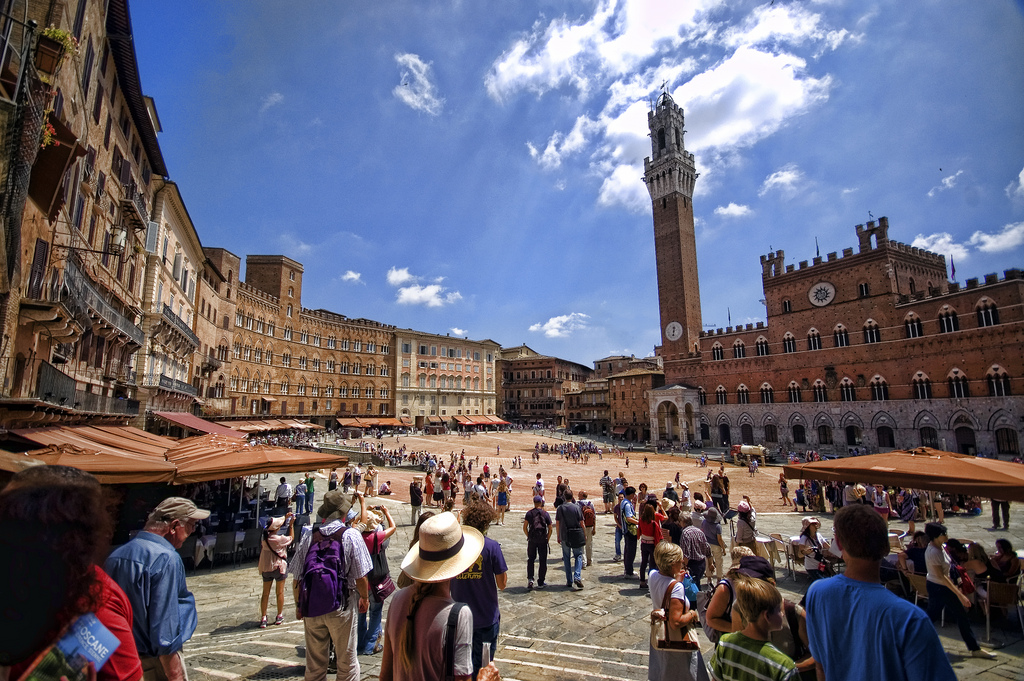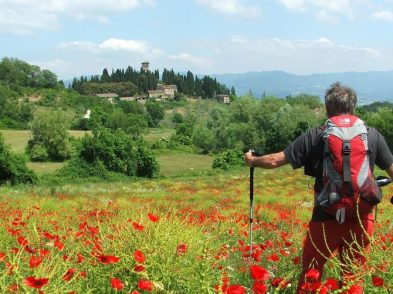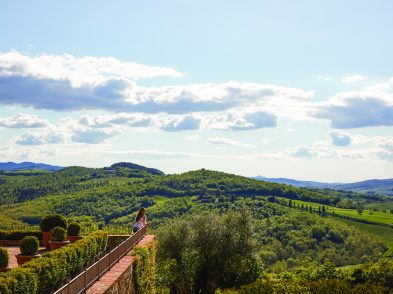Siena has a more insular and less forthcoming atmosphere than Florence – but it’s one you definitely should get to know. If you have little time to spend in the city, use it wisely by wandering the steep and twisting streets, viewing the numerous palazzi, the Duomo, the Campo, churches and shops filled with local produce. But it is best to spend at least one day visiting some of the museums.
First stop on anyone’s list should be the shell-shaped Campo that is the heart of Siena and the place where the famous horse race, the Palio, happens twice a year. In what is claimed to be most beautiful piazza in Italy, you will find the Palazzo Pubblico and the Torre del Mangia – as well as numerous cafés and restaurants vying for the tourists’ cash. Ignore the prices and sit down with a coffee, enjoying the view for 15 minutes before making your way into the Museo Civico in the palace. Begun in 1297, the Palazzo Pubblico is a monument to Siena’s past achievements. Not only beautiful to look at on the outside, inside you will find some of the most important pieces of Siena’s art history. In the Sala della Pace is Ambrogio Lorenzetti’s triumph, The Allegory of Good and Bad Government, which was painted in 1338 and was there to remind the ruling council of what they should and shouldn’t be doing. Therefore, on one wall the fresco shows a thriving city that is clearly Siena, where people are working at all trades and the land outside the city walls thrives. On the opposite wall, there is Bad Government, with a city ruled by a demon, where thieves thrive and everyone looks after themselves rather than working together for the common good.
Other highlights in the palazzo include a fabulous Maestà by Simone Martini and two chapels painted by Taddeo di Bartolo. Don’t miss climbing up the steps to the Loggia, where the Council of Nine used to get some fresh air because they were unable to leave the Palazzo Pubblico during their term of office, which usually lasted two months. The views of the market square and surrounding area are beautiful but if you are unafraid of heights then you really should climb the 503 steps of the Torre del Mangia. Looking down on to the winding streets of this medieval, orange-coloured city is amazing, before your eyes drift over the rolling hills of the Tuscan countryside.
Another vantage point is the Museo dell’Opera Metropolitana, or more precisely, a section of the ‘new’ Duomo, which was to be an extension of the old one. Building started in 1339 to celebrate the success of Siena, as well as make the cathedral bigger and better than the recently began Duomo of Florence. Unfortunately, the Black Death came along in 1348, wiping out more than half of the population. It caused such chaos for the political regime that never again did Siena reach such heights. The new Duomo was never finished and remains a constant reminder of the city’s failure. The façade is a much easier climb than the Torre del Mangia and definitely worth the effort for the sea of roof tiles that awaits you at the top, as well as a perfect view of the Palazzo Pubblico.
The rest of the museum features numerous pieces of beautiful Sienese art, including Duccio’s monumental Maestà. Visitors can appreciate a double-sided altarpiece painted in the early 1300s; on completion it was paraded through the town in triumph before being placed on the high altar of the Duomo. From the museum, head into the Duomo itself, which is strikingly decorated with zebra-striped bands of black and white marble. Once inside, look out for Nicola Pisano’s pulpit of 1269, the marble pavement featuring 56 panels crafted over 200 years by almost every artist who worked in the city. Then look for what I consider the cathedral’s crowning glory, the Piccolomini Library, which has a series of brightly-coloured sixteenth century frescos by Pinturicchio, celebrating the life of Pius II.
If during all this touring, you need sustenance, head down the hill to Le Campane Ristorante, at Via delle Campane 6, just off one of the main thoroughfares, Via de Città. They serve fabulous Sienese food, so take time to enjoy dishes like the pasta with wild boar sauce, pecorino-filled ravioli and roasted meats. And if, after all that pasta, you still have the energy to continue, further sightseeing recommendations include Santa Maria della Scala, the medieval pilgrim hospital opposite the Duomo that is now open for everyone to view the frescos which until the 1980s were only visible to the ill. Or visit the Pinacoteca Nazionale, an art gallery featuring all the greats of Sienese Gothic painting and the Palazzo Piccolomini, the state archive museum where you will find the Biccherna tablets. These beautiful and interesting pieces of art were used as the covers for the city’s accounts books from the thirteenth century onwards and are perfect for those interested in both history and art – as is the whole of Siena.
Please note that the best way to get to Siena from Florence is by bus, which takes just over an hour and stops right in the centre of the city, in Piazza Matteotti. Buses depart from Florence at the bus station on Via Santa Caterina, next to the railway station of Santa Maria Novella.





